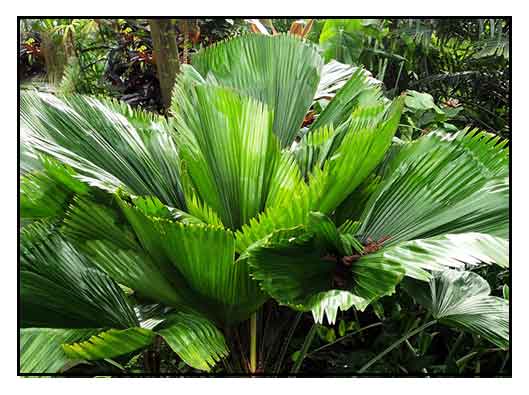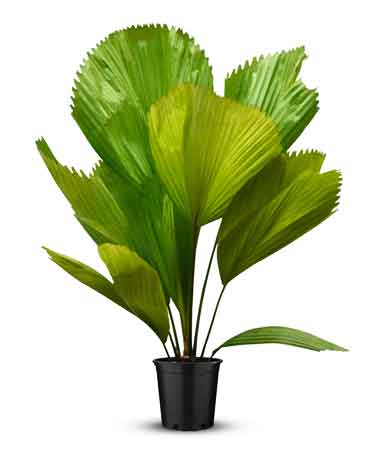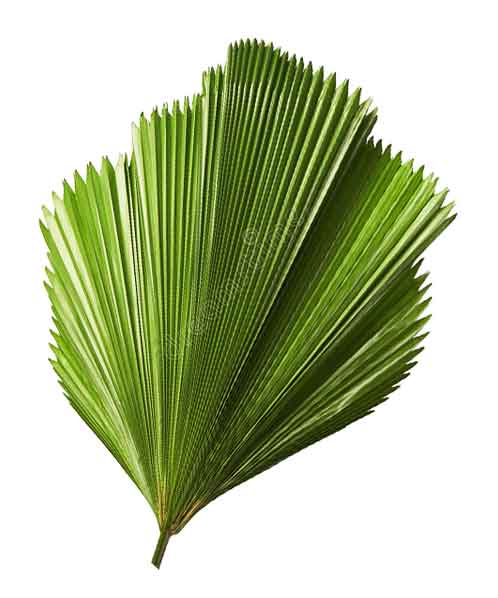 Botany Botany
Licuala grandis is an palm growing to a height of 5 to 6 feet. Stems are upright and solitary, 3 meters tall and 5 to 8 centimeters in diameter, ridged with leaf scars and some remnant fibers from leaf sheaths. Leaves are costapalmate, large, yellow-green to deep green, undivided, entire, corrugated, with a stiff, undulating blade, forming a fan-like semi-circle. Leaf tips are bifid. Petioles have a prominent hastula, armed toward the base with small, curved teeth along the fibrous margins. The mid-rib extends almost one-third the length of the leaf blade. Inflorescences are 2 meters long, branched in three orders and extending beyond the leaves. Flowers are small, white, and bisexual. Fruits are small, round, 1 to 1.5 centimeters, red or red-orange when ripe. (8)
Botanical distinctions: May be confused with other Licuala species, but the rounded, entire leaf blade are quite distinctive. The leaf of L. grandis appears palmate from a distance; however, the petiole extends into the leaf blade to form a slender, arrow-shaped costa. (8)
 Distribution Distribution
- Introduced.
- Native to Australia.
- Ornamental cultivation.
Constituents
- Phytochemical screening of methanol extract of leaves yielded reducing sugar, tannins, steroids, alkaloids, glycosides, proteins, acidic compounds, with absence of flavonoids, saponins, and gums. (see study below) (3)
- Study of seed oil for component fatty acids yielded (wt%): lauric acid, 2.5; myristic acid 2.3, palmitic 27.4, stearic 15, arachidic 1.4, behenic 2.1, oleic 33.4, and linoleic 29.0. (6)
- A comprehensive analysis of terpenoids yielded caryolan-1-ol, a relatively minor product: Study suggested caryolan-1-ol is a non-enzymatic product of the bicyclic sesquiterpene hydrocarbon ß-caryophyllene, a major sesquiterpene in plants. (7)
Properties
- Studies have suggest antioxidant and analgesic properties.
Parts used
Leaves..
Uses
Folkloric
- No reported medicinal use in the Philippines.
- In Maewo, Vanuatu,, leaves are used to cure headache in men caused by contact with menstrual blood: The tough leaf is crushed and the pulp is mixed with a little water, which is spread on the patient's head, repeated daily until recovery. (4)
Others
- Ornamental: Ornamental cultivation.
-
Functional uses: In Vanuatu, leaves are used as traditional umbrellas or improvised in case of sudden rainfall. Leaves used as plate and for wrapping of folk-art objects.(4)
- Social symbol of status: In Vanuatu, the leaf is specifically symbolic for a woman who has passed the initial grade, rabankamel, held in hand or slipped into her belt, indicating that she has successful attained that status. (4)
 Studies Studies
• Antioxidant / Analgesic: Study evaluated the antioxidant and analgesic activities of three Bangladesh medicinal plants: Bougainvillea glabra, Licuala grandis, and Anthurium crystallinum using DPPH assay, total phenolic and total tannin contents for antioxidant activity and acetic acid writhing and tail flick test in mice for analgesic activity. The 50% inhibitory concentration of a methanol crude extract of L. grandis 2.18 µg/ml, compared to standard ascorbic acid of 3.90 µg/ml. Total phenolic content was 247.272 ± 0.016 mg GAE/100g. and total tannin was435.7 ± 0.01 mg GAE/100g of dried plant extract. All three extracts reduced pain in both methods in a dose-dependent manner. (3)
• Mechanical Behavior of the Natural Fiber Reinforced Composite: Study evaluated the mechanical behavior of palas leaf (Licuala grandis) reinforced composite. Measures of tensile, impact and flexural properties were carried out on composites made by reinforced palas leaf as a new natural fiber into polypropylene homopolymer resin matrix. For tensile modulus, flexural strength, and flexural modulus, the value increased as fiber content increased. The optimum composition was 60% polypropylene and 40% palas fiber. The palas leaf reinforced composite showed higher value than the neat polypropylene. Palas leaf is low cost, ecofriendly, and recyclable. (5)
Availability
- Wild-crafted.
- Ornamental Cultivation.
- Seeds in the cybermarket.
|

![]()






